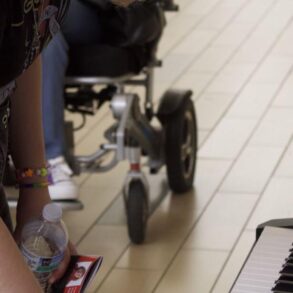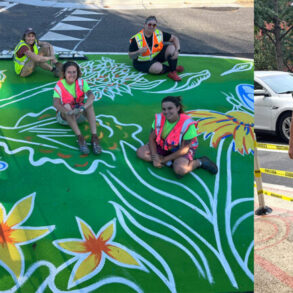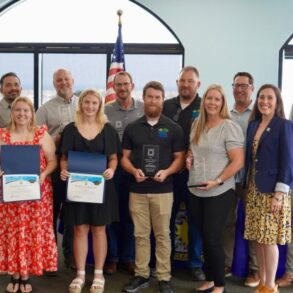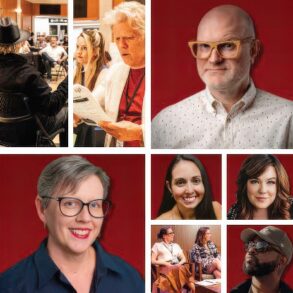In a pasture, one man’s deer skull is another man’s sculpture.
There is more than one iteration of sculptor Joe Barrington’s fascination with a found deer skull. The difference in size between the art and the subject, however, ensures one will never be mistaken for the other. Like some of his most famous works, the scale on these skulls, along with their accompanying antlers, comes closer to Godzilla than garden gnome.
On Saturday, Barrington entertained members of the Abilene Creative Arts Club with anecdotes and stories behind his 45-plus years as an artist during the group’s monthly meeting at 1117 Studios & Gallery.

“I was walking through a pasture one day, and I see a deer skull laying on an ant bed on its side, and it’s stark-white because the ants had cleaned it up. It was sitting right on top of that mound,” he recalled, describing part of his process.
“I looked at that, and I thought, ‘That would be a great sculpture,’” he said.
Barrington’s father, Eddie, always believed in his son’s passion. But still …
“So, I come home, and I start building this 10-foot-wide deer skull. And my dad was like, ‘What are you doing?’” Barrington said, laughing. “He was always real supportive, but sometimes he was like, ‘I don’t know what you going to do with that.’”
There’s not a huge art market in Throckmorton, Barrington’s hometown. But there certainly is in the nation’s larger cities after budgets for outdoor public art took off in the 1980s.

But you’re not going to go door-to-door trying to sell a 10-foot-wide deer skull sculpture to each municipality you find. You need them to come to you.
“I said, ‘Well, I’m gonna put it in a show first,’” answered Barrington to his father. “So, I took it to Dallas. There was a show down there called Connemara that was a conservation thing out north of Dallas. It sold in the first week.”
Connemara Conservancy still holds their annual Spring in the Meadow artist invitational even each year on the Saturday before Memorial Day. Artists visit the Connemara Meadow Nature Preserve, a 72-acre protected area between Plano and Allen, to be inspired by its natural beauty.

One of Barrington’s deer skulls can be seen at the corner of North First and Hickory streets. Another has been spotted off U.S. Highway 351 south of Albany a few miles.
But arguably his most well-known piece is the Bridle Bit Bull along U.S. Highway 380, 10 miles east of Throckmorton on the McKnight Ranch.
“That was a commissioned piece by Ross McKnight who owns that ranch. That was formerly the Swenson Ranch out there, and he’s been a friend and an early patron of mine,” Barrington said.
McKnight had already bought one of Barrington’s large roadrunner renditions when he saw the 13-foot tall bull being worked on in the shop.
“He said, ‘I like that bull, I want one,’” Barrington said, recalling the conversation.
“’Okay, we’ll do one,’” he replied to the rancher.
“I want a bigger one,” McKnight answered.
“Well, how big a bull do you want?”
“I’m thinking about 25 feet tall.”
After they installed the statue, the bull had the misfortune to encounter a tornado in its first month. McKnight sent Barrington a picture of the bull on its side, and without a word, Barrington grabbed his team to drive out and stand the bull back up.
“We really installed it this time,” he said. “I think it would blow the horns off before the legs break off, now.”

The proof of its popularity can be seen in the number of pictures Barrington receives from passersby. Outside of Haskell and Throckmorton, the statue isn’t really on the way to any big city. To get to it, you’ve got to want to see it.
“I didn’t really see that when we put the piece up, that it would be that popular,” he said.
Artists aren’t always known for their business acumen; they might argue that’s what an agent is for. But that’s not how Barrington was raised.
“I always thought about making art as a business,” he said. “A lot of artists don’t think of it (that way). They don’t think they need insurance. But I grew up in a small family business. I was always aware of what it took to make that work.”
That’s part of what keeps him in Throckmorton. It’s a lot easier on a business like his to operate in a small town where costs are low, land is plentiful and strangers don’t stay that way for very long.
But even though his is a business, it’s the creative spark behind it all that is the most fragile and always in need of shepherding.
“You’ve got to still build stuff for yourself. You know if you don’t, it becomes like ‘work,’” he said.
That is to say, the art becomes an exercise in repetition. The design may be sound, but that spark driving creation becomes smaller, duller.
“So, I work on something for me,” he said. “And it might be something that I never do anything with, you know, or something for my house.”
That’s because art isn’t about the product; it’s about the process. What’s produced may not go anywhere, but the process that carried the artist along is sure to lift him to a new place where it does.
That takes risk, but without it there’s no reward.
“You just gotta put your work out there,” Barrington said.
More:Memories of moments from 2024, captured or experienced for the Abilene Reporter-News
More:The steers come out at Mitchell County Livestock show
This post was originally published on this site be sure to check out more of their content





